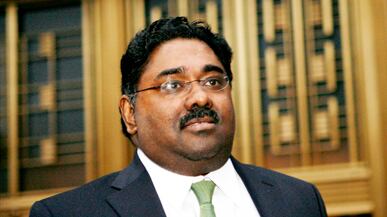Following every financial collapse, a cast of Wall Street bad guys invariably parades through the dock, from Depression-era thief Richard Whitney to junk-bond king Michael Milken to Ponzi schemer Bernie Madoff—media-saturated jaunts down the Via Dolorosa calculated to reassure the public that the financial markets are being policed, even though they’re not. This week, it’s the somber, bespectacled, self-made billionaire Raj Rajaratnam on display, as the biggest insider trading trial in decades heads to the jury.
Rajaratnam was not a player in the 2008 financial crisis. Like Madoff, he’s a kind of consolation prize, a distraction from the fact that none of the meltdown’s central figures have even been indicted. But as the trial has made clear over the past six weeks, he represents even more: the living embodiment of a changing Wall Street—not in its immorality, which is a permanent fixture of finance, but in its ethnicity. Wall Street is no longer a white-man's preserve. South Asians—Indians, Pakistanis, Bengalis, and Sri Lankans—are ascendant.
This new South Asian Wall Street elite includes the CEO of Citigroup, Indian-born Vikram Pandit; Ajit Jain, also from India, a money manager emerging as the likely successor to investment guru Warren Buffett; and a half-dozen hedge-fund managers who use strategies based on mathematical algorithms to routinely rake in $50 million or more per year in income. Chief among the latter group is the Sri Lankan-born Rajaratnam, who ran a $7 billion hedge fund, Galleon Group, and largely to the disgust of this justifiably proud community, has emerged as the face of this new ethnic order.
In much the same way that the upwardly mobile Jewish community of the 1930s viewed Jewish gangsters as a "shanda fur die goyim" (shame before the gentiles), the “Raj trial” has put the South Asian financial clique on full display, for all its success—and insularity.
Over the past weeks, jurors have heard testimony from Anil Kumar, an old college buddy and former McKinsey executive who pleaded guilty to getting $2 million from Rajaratnam in return for inside information; Rajiv Goel, a former Intel executive who also pleaded guilty and now says he fed Rajaratnam tips about his old employer; and another witness who says Rajaratnam’s brother, Rengan, hastily removed office files the day the Feds started making arrests. Even the prosecutor, steely Preet Bharara, who made his bones ferreting out the firing of U.S. prosecutors who refused to pursue political cases for the Bush administration, is Indian-born.
Wall Street, for its first 200 years, remained a WASP preserve where prejudice was practiced openly.

Meanwhile, the Securities and Exchange Commission has filed civil charges against another alleged Rajaratnam tipster, respected Indian-American mogul Rajat Gupta, who was a member of the boards of Goldman Sachs and Procter & Gamble, and managing director of McKinsey & Co., the global consulting firm. Gupta's involvement is "a big hit for the Indian community," laments Rajiv Garg, who was head of global risk management at Credit Suisse and now is CEO of a New York hospital.
While outsiders can’t help but note the ethnic clubbiness, to South Asians, it’s merely an extension of a style of business—working a network of friends and acquaintances—that’s played out for centuries on the subcontinent, only applied, in this case, for allegedly criminal ends. “When you come from a different country, you have to make a whole set of new friends very quickly,” says one South Asian financier who requested anonymity. “The church and the country club have played that role in American society for a very long time. Every diaspora tries to find a way of accommodating.”
In theory, there was a certain inevitability to the influx of South Asians to the financial sector. India was a center of commerce and trading when Europeans were still painting themselves blue, and ancient trading centers like Karachi and the Indian state of Gujarat, on the Arabian Sea, gave rise to a mercantile tradition carried on for centuries by the Memons, a predominantly Sunni Muslim ethnic group that dominates the Karachi markets to this day, and the Marwaris of the princely state of Rajasthan in northwest India.
Yet Wall Street, for its first 200 years, remained a WASP preserve, where prejudice was practiced openly. Anti-Semitism was most commonplace—to ultimately succeed, Jews had to found their own banks—and South Asian old-timers faced even more virulent intolerance, especially in London, where many educated Indians emigrated in the mid-20th century. Garg, who was employed by Bankers Trust in London during the 1980s, recalls that a financial headhunter once told him not to count on moving up: "You're not the right color and you don’t wear the right school tie.”
Technology, specifically the advent of computerized trading, changed all that. Suddenly, math skills were the most valuable commodity, and discrimination quickly became as unprofitable as it was immoral. "Milton Friedman made the point that discrimination takes place in noncompetitive environments," says Tony Elavia, an Indian-born hedge-fund manager. "People are in such high demand that discrimination would be an expensive proposition for anyone who engaged in it." The banks snapped up the output of mathematicians, engineers, and economists emerging from India's schools, such as the prestigious Indian Institute of Technology, as well as other bright young Indians gaining graduate degrees at American universities. "The trend over the last 15-plus years have played naturally to the backgrounds of people coming out of India's schools," adds Chaith Kondragunta, an Indian-born analyst who has started up his own research firm, Analytixinsight. Besides meeting the Street’s voracious demand for quantitatively trained young people, South Asians held an advantage over similarly hungry Russians and East Asians: They spoke English as their first tongue.
Ironically, the ascendance has been so complete that much of the remaining stereotyping exists among South Asians themselves. "You'd be surprised how the Indian system is so stratified," says Usman Memon, an Indian-born Texan of, as his name implies, Memon extraction who co-founded Streebo, an information technology firm. With a trading tradition that goes back to the days of camel caravans, Memons are, he says approvingly, "the Jews of Muslims," and a fixture on Wall Street. Ditto Punjabis, who hail from the region straddling the India-Pakistan border, have long dominated India's military, and tend to drift toward risk-taking fields like finance. (Prominent Punjabi-American bankers include MasterCard's CEO Ajay Banga, who headed consumer banking at Citigroup.) "They're physically less timid,” says Garg, who contrasts Punjabi freedom fighter Bhagat Singh, who "wanted to kill the English," with the measured, nonviolent Mahatma Gandhi, who was Gujarati—a group less prevalent in finance.
The very meritocratic forces, though, that led to the rise—and fall—of Rajaratnam will eventually knock down even those caste stereotypes. "If you're from the South and want to move up in life, you realize you have to go into business for yourself or go into an industry where color doesn’t matter," says a stockbroker of Pakistani heritage, whose firm's policy did not allow use of his name. "The main color in the financial industry is green." And that will remain true even after the Raj trial recedes into memory.






